World winter barley yield record broken in Lincolnshire
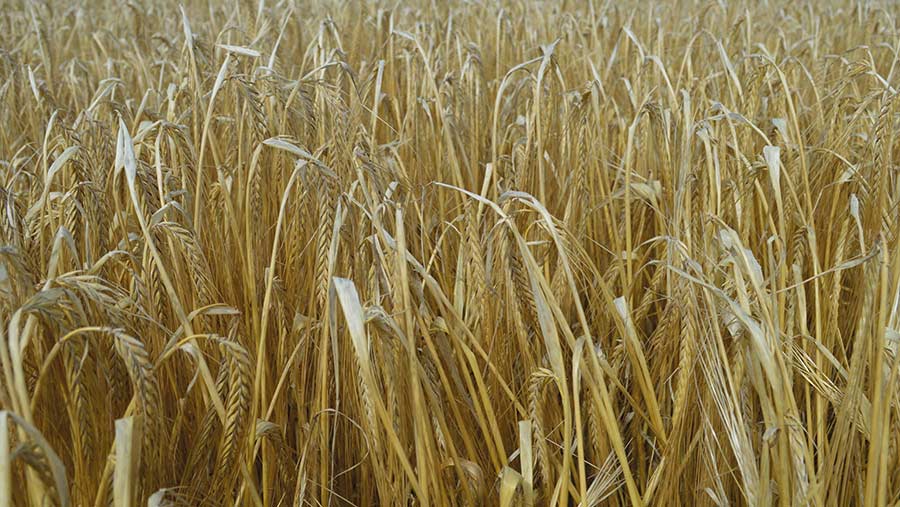 © MAG/David Jones
© MAG/David Jones Lincolnshire Wolds grower Tim Lamyman has broken the world winter barley yield record by nearly 0.5t/ha as a three-week-late harvest allowed more time for his crops to grow and the grains to fill.
His yield of 14.2t/ha beat the old record of 13.8t/ha, set by New Zealander Warren Darling, in a UK growing season when the weather appeared to favour winter barley.
“We are extraordinarily excited as this is our third attempt at the record in the same field,” Mr Lamyman tells Farmers Weekly.
See also: Bumper grain yields in Yen awards despite tough season
Formula for success
The success came growing the KWS-bred two-row feed variety Tardis using 250kg/ha of nitrogen fertiliser, a five-spray fungicide programme and multiple use of micronutrient foliar feeds.
The barley crop was kept clean of disease and threw up a lot of big ears, with an average of 28 grains a head, which Mr Lamyman said was “incredible” for a crop that showed 1,000 heads/sq m in the field.
“The variety’s ability to tiller and its ability to stay green as long as possible is as good as any variety I have ever seen,” he adds.
The crop showed four green upper leaves to intercept sunlight as late as 7 July, with the crop harvested only four weeks later on 5 August.
Late harvest
This season’s winter barley harvest came three weeks later than last season, which had started on 7 July, giving a prolonged growing season allowing the grains to fill and give a good specific weight of 64kg/hl, as Mr Lamyman says the crop “captured three weeks more sunlight”.
The record-breaking crop was drilled on 17 October at Mr Lamyman’s 600ha farm at Worlaby, just north of Horncastle, into his chalky loam Wold soil at a seed rate of 200kg/ha.
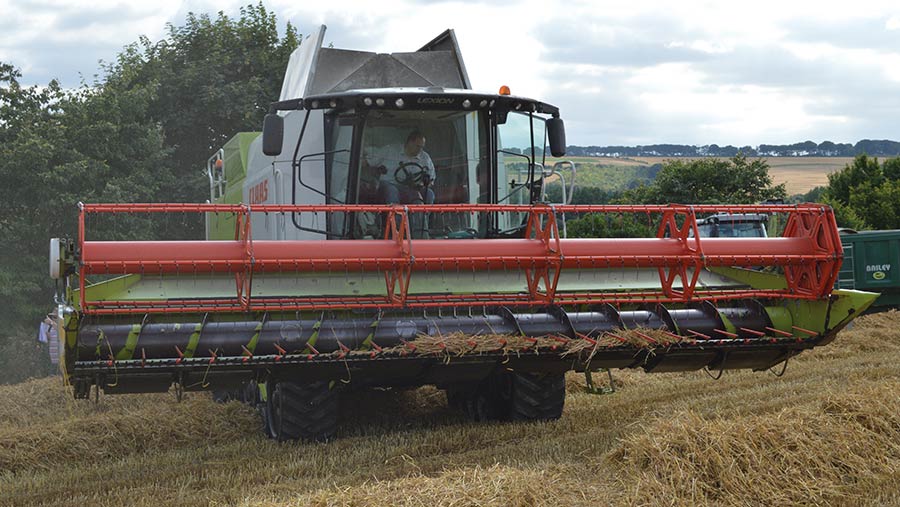
© MAG/David Jones
He usually drills his winter barley between 10-28 October, and he ploughs after a preceding crop of winter wheat to stop any contamination of his seed barley crop with wheat plants.
The crop was treated with two micronutrient foliar feeds in the autumn and four in the spring, along with a four-way split of 250kg/ha of solid ammonium nitrate in the spring.
Variety harvest
Mr Lamyman cut the variety Hawking at a yield of 9.5t/ha, Bolton at 10.9t/ha and one block of Tardis at 11.5t/ha and then another 8.6ha block of the same variety at 14.2t/ha at 15% moisture.

Tim Lamyman © MAG/David Jones
This final block of Tardis produced 880-1,050 heads/sq m, and although 35% of the crop had started to go down, it still gave a good yield and specific weight, and Mr Lamyman was impressed with the variety.
“Next year, the whole of our winter barley area of about 100ha will be Tardis,” he adds.
The extra nitrogen fertiliser, foliar feeds and fungicides costs amount to some £250/ha of additional spend compared to standard farm treatments, but it obviously paid for itself in terms of extra yield.
Green leaf area
David Robinson, head of crop dynamics at agronomy group Frontier, says that the key to the high yield was picking a stiff-strawed, clean variety that built up good root mass to prepare for any dry spell of weather in the spring.
“The crop held on to a lot of green leaf area as long as possible to give maximum light interception,” he says.
Andrew Smooker, agronomy manager at agrochemicals group BASF, says the fungicide programme looked to control rhynchosporium and late attacks of brown rust, and used the new azole mefentrifluconazole to protect against ramularia disease.
“It was a broad-spectrum fungicide approach with a T2 focused on the ramularia threat, especially with the absence of chlorothalonil,” he says. No multisite protective fungicides were used, and the money saved allowed higher rates of SDHI fungicides to be applied. The multisite chlorothalonil was banned from use in May 2020.
Maximum potential
Mark Carter, director of foliar feed group Bionature, says: “The aim was to set the crop up for its maximum potential by supporting plants early.”
The group makes a number of products including micronutrient, nitrogen and potassium product Delta, and three other micronutrient products: TipTop, Calflux and Xstress.
New Zealand South Island grower Mr Darling harvested his irrigated winter barley crop in February 2015 at 13.8t/ha, breaking a 26-year-old record set by Scottish grower Gordon Rennie, with a 1989 crop of 12.2t/ha.
Programme for winter barley
- Variety Tardis
- Drilling date 17 October at a seed rate of 200kg/ha
- Nitrogen 250kg/ha in four splits
- T0 Azole prothioconazole, plant growth regulator trinexapac-ethyl (Moddus)
- T1 SDHI fluxapyroxad + strobilurin pyraclostrobin (Serpent) + azole mefentrifluconazole (Myresa) + mildewicide cyflufenamid (Cyfamid), PGRs Moddus and chlormequat, Delta, magnesium and boron
- T2 Fluxapyroxad + mefentrifluconazole (Revystar), PGR ethephone (Cerone), Xstress, magnesium and boron
- T3 Prothioconazole, strobilurin azoxystrobin (Amistar), TipTop, Xstress and Calflux
- T4 Azole tebuconazole
- Yield 14.2t/ha at 15% moisture, cut 5 August
- Specific weight 64kg/hl
Note: Two Delta applications were made in the autumn
Winter wheat
Mr Lamyman had his best ever start to winter wheat harvest with his first crop yielding 15t/ha at 18% moisture and is hopeful for bigger yields from later-cut crops.
“We have never had a record with a first-cut wheat, and our best ever first-cut wheat was three years ago with a yield of 13.8t/ha,” he says.
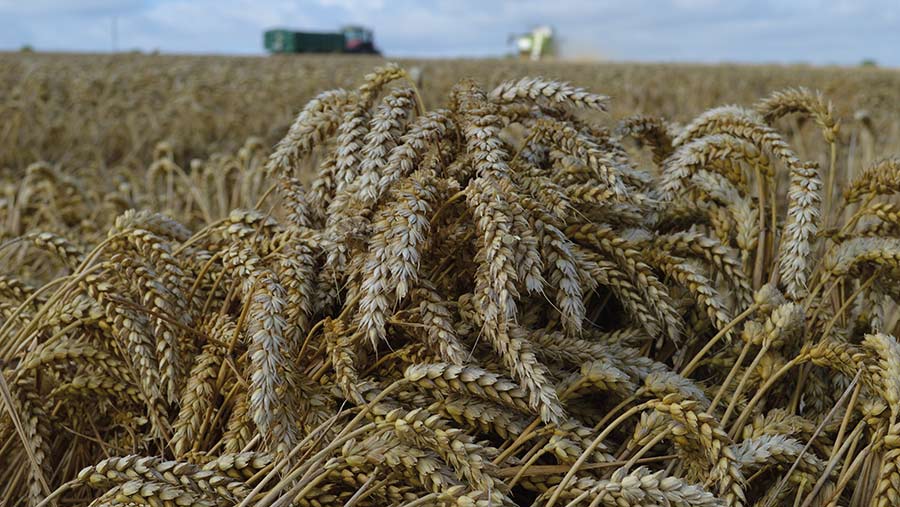
© MAG/David Jones
He picked the feed wheat variety Theodore, from breeder DSV, for its potential for high yields if the variety was drilled between 20 September and 1 November and then pushed for yield.
Last season, Theodore was grown on the farm for the first time and yielded 9.7t/ha, 12t/ha and 14t/ha with 220kg/ha of nitrogen and on a farm-standard fungicide programme, so Mr Lamyman decided to try to get more yield this season.
High-yield formula
He drilled the variety on 30 September at a high seed rate of 250kg/ha, giving 450 seeds/sq m, rather than the farm’s normal 200-210kg/ha as it is a shy-tillering variety.
Theodore has the highest resistance rating for septoria on the AHDB Recommended List at 8.3 above the next best Extase at 8.0, on a 1-9 scale where 1 is very susceptible and 9 shows good resistance.
“It was a clean wheat with real potential, and it seemed to keep four green leaves forever,” says Mr Lamyman.
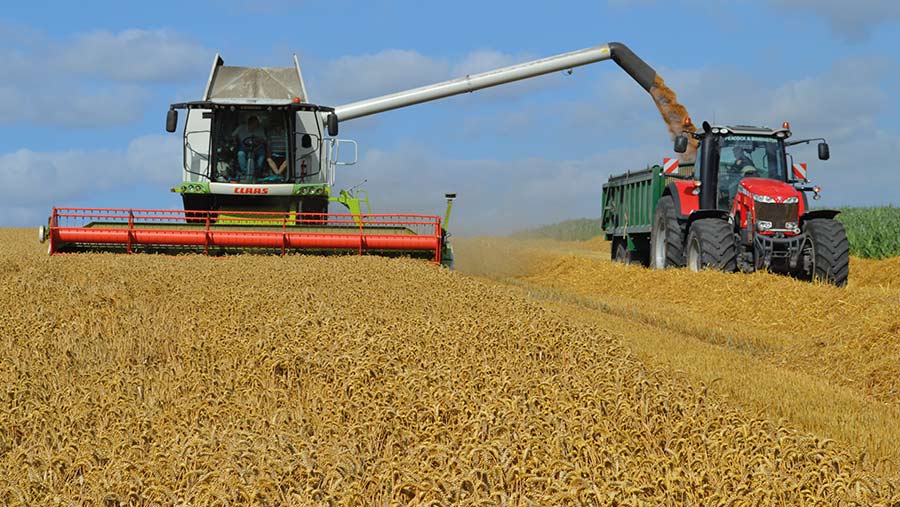
© MAG/David Jones
The variety, when harvested on 18 August, showed a population of 770 head/sq m, in line with the farm’s aim of at least 700 heads for high-yielding crops.
Crops of the varieties Colosseum and Champion, set to be harvested later, are also looking good and Mr Lamyman is optimistic that they may yield more than the Theodore.
Shy at tillering
Michael Farr, arable technical lead at DSV, agrees that the variety needs a high seed rate as it tillers less than many other wheat varieties.
“It is very strong on the main diseases but growers need to watch for brown rust at the end of the season,” he says.
He suggests growers can cut out a T0, have a reduced T1 and then focus on T2 and T3s when growing the variety, and notes that growers will not have to use the most expensive chemistry on this variety because of its good disease resistance.
The world wheat record is held by New Zealander Eric Watson with a yield of 17.4t/ha cut in February 2020, with the UK yield record held by Rod Smith in Northumberland, who grew a crop yielding 16.52t/ha in 2015, while Mr Lamyman’s best yield, also in 2015, came in at 16.5t/ha.
Mr Lamyman’s approach to growing wheat calls for a high level of variable costs in terms of sprays, fertiliser and seed of about £800/ha, but has a relatively low level of fixed costs including machinery, labour and financing at £400-£500/ha.
Programme for Theodore winter wheat
- Drilling date 30 September at a drilling rate of 250kg/ha
- Nitrogen 350kg/ha with five splits
- Pre-T0 Moddus, Delta
- T0 Azoles prochloraz and tebuconazole, Moddus, chlormequat, magnesium and boron
- T1 Fluxapyroxad + mefentrifluconazole (Revystar), tebuconazole, Moddus, chlormequat, Delta, Xstress
- T1-1/2 Mildewicide cyflufenamid (Vegas), Cerone, TipTop, magnesium and boron
- T2 Fluxapyroxad + pyraclostrobin (Syrex), mefentrifluconazole (Myresa), Xstress, magnesium and boron
- T3 Prothioconazole, azoxystrobin, TipTop, Xstress, Calflux
- T4 Tebuconazole
- Yield 15t/ha at 18% moisture, cut 18 August
Note: Two Delta applications were made in the autumn
Oilseed rape
A mix of two oilseed rape varieties were drilled in late September to try to avoid the worst of any attacks from cabbage stem flea beetles, and this crop yielded an impressive 6.5t/ha.
Mr Lamyman explains that he tried drilling a slow-developing convention variety with a fast-developing hybrid, and the flea beetles appeared to prefer to feed on the smaller plants of the former.
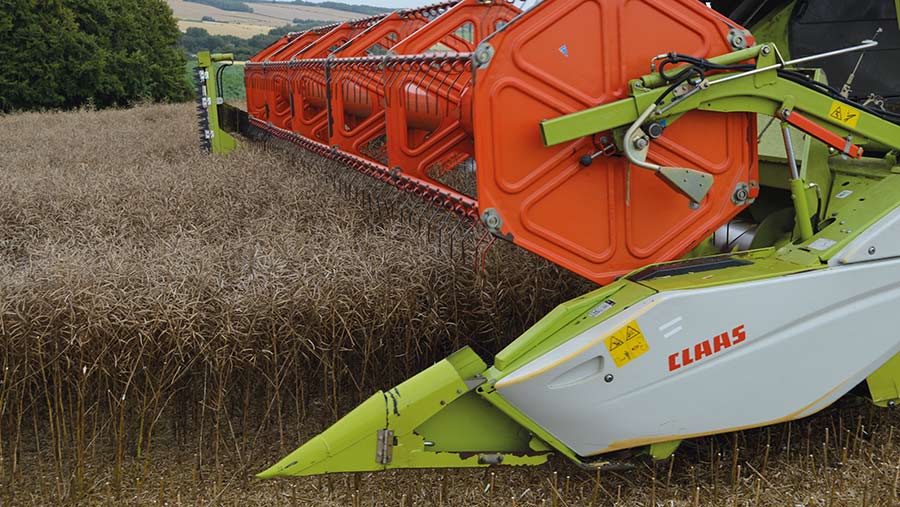
© MAG/David Jones
He drilled a mixture of the conventional variety Acacia and hybrid Antigua on 26 September at 35 seeds/sq m each to give an overall 70 seeds/sq m, which produced about 35-38 plants/sq m.
This is the second season he has tried this approach and says drilling rapeseed with rapeseed avoids the problems of killing off any companion crops that might be used to deflect flea beetles.
He says that with milder autumns, the later drilling date has worked well on his farm high on the Lincolnshire Wolds.

